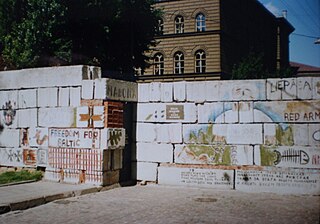 W
WThe anti-nuclear movement in Kazakhstan, "Nevada Semipalatinsk", was formed in 1989 and was one of the first major anti-nuclear movements in the former Soviet Union. It was led by author Olzhas Suleimenov and attracted thousands of people to its protests and campaigns which eventually led to the closure of the nuclear test site at Semipalatinsk in north-east Kazakhstan in 1991. The movement was named "Nevada Semipalatinsk" in order to show solidarity with similar movements in the United States aiming to close the Nevada Test Site.
 W
WFollowing the rise of nationalism and political tensions, as well as the outbreaks of the Yugoslav Wars, numerous anti-war movements developed in Serbia. The 1991 mass protests against Slobodan Milošević regime which have continued throughout the wars reinforced young people's antiwar orientation. The demonstrations in Belgrade were held mostly because of opposition the Battle of Vukovar, Siege of Dubrovnik and Siege of Sarajevo, while protesters demanded the referendum on a declaration of war and disruption of military conscription.
 W
WThe January Events, commonly referred to as Bloody Sunday, took place in Lithuania on January 11–13 1991 in the aftermath of the Act of the Re-Establishment of the State of Lithuania. As a result of Soviet military actions, 14 civilians were killed and over 140 were injured. The events were centered in its capital, Vilnius, along with related actions in its suburbs and in the cities of Alytus, Šiauliai, Varėna, and Kaunas.
 W
WThe Karabakh movement was a national mass movement in Armenia and Nagorno-Karabakh from 1988 to 1991 that advocated for the transfer of the mainly Armenian-populated Nagorno-Karabakh Autonomous Oblast of neighboring Azerbaijan to the jurisdiction of Armenia.
 W
WThe San Marcos Seven were seven demonstrators—Angela Atkins, Jody Dodd, Daniel Rodrigues Scales, Bill O’Rourke, Joe Gaddy, Jeffrey Stefanoff, and Joe Ptak—convicted of misdemeanor possession of cannabis following protests at the San Marcos, Texas, police station in March, 1991.
 W
WThe 1991 protest in Split was a street protest against the Yugoslav People's Army held in Split, Croatia on 6 May 1991. The protest was organised by the Croatian Trade Union Association in the Brodosplit Shipyard and joined in by workers from other companies in the city and other residents of Split after radio broadcast appeals for help while the protesters marched through the streets. Ultimately, the protest drew 100,000 supporters.
 W
WThe Barricades were a series of confrontations between the Republic of Latvia and the Union of Soviet Socialist Republics in January 1991 which took place mainly in Riga. The events are named for the popular effort of building and protecting barricades from 13 January until about 27 January. Latvia, which had declared restoration of independence from the Soviet Union a year earlier, anticipated that the Soviet Union might attempt to regain control over the country by force.